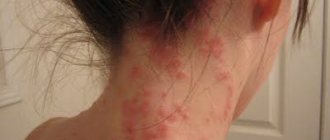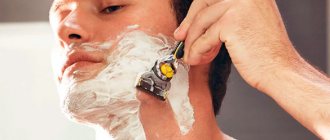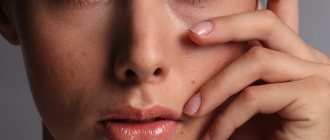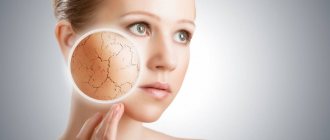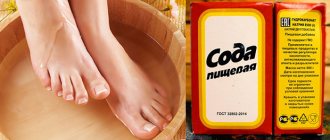Peeling heels are not a very good or pleasant sensation. And all women will agree with this. And if it’s summer outside and it’s just the right time to wear open sandals, then it’s doubly offensive. Outwardly, it does not look aesthetically pleasing at all - flaky, dry skin that peels off, cracks appear, and the heel becomes rough and rough. Any woman faced with such a problem asks herself the question: why did this happen, how to stop this process and how to deal with it? Below we will describe the main causes of peeling heels and options for eliminating this problem.
Why does the skin on my toes peel off? Fingers and toes
Many people have encountered various problems on their feet.
One of them is peeling of the skin on the sole. This phenomenon usually does not cause alarm, but the situation worsens over time and this complicates treatment and entails unpleasant consequences in the future. The problem is not only a cosmetic defect, but also a pathology of a medical nature. To find out why the skin on your feet is peeling and peeling, you need to consult a qualified specialist in the field of dermatology.
Causes of redness and peeling on the feet
Doctors identify several main causes of redness and peeling on the feet:
- The shoes are of poor quality and the wrong size. Tight shoes made of synthetic materials limit air access to the surface of the skin. The feet sweat intensely, the skin becomes loose and begins to peel between the toes. Excess humidity can provoke the formation of pathological viruses and the proliferation of pathogenic bacteria and microbes. To prevent this, you need to keep your shoes in order, change the covers, and dry them regularly.
- Insufficient care of the skin of the feet, non-compliance with personal hygiene. Dead scales of the dermis clog the pores, which interferes with normal air circulation. To stop this process, it is necessary to systematically make foot baths and remove dry particles using pumice. For the heels, use large-pored pumice, and for the toes, fine. After polishing your feet, treat clean skin with cream with nourishing ingredients.
- Heredity. It happens that the upper layer of the epidermis peels off on the skin due to excessive dryness of the tissues. The skin needs frequent renewal, so redness, small cracks, and white scales appear on it.
- Systematic stressful situations. There is an opinion among doctors that the most bioactive points of a person, which are responsible for the functioning of the nervous system, are concentrated on the feet. Therefore, stress negatively affects the condition of the skin.
- Lack of vitamins A and E in the body. In this case, skin problems often have a seasonal cycle. Vitamin deficiency can be caused by another factor - poor nutrition. Peeling skin is caused by insufficient nutrients in a person's daily diet.
- Using hard water for bathing, foot baths, etc. The surface of the skin dries out and, as a result, becomes covered with small cracks and begins to peel off.
- Fungal infection. As a rule, such an infection can be obtained by wearing someone else's shoes, while visiting public places, such as a bathhouse, swimming pool, sauna, gyms. The fungus actively affects the skin of the legs, spreading to the feet, fingers, and nails. Disruption of natural processes leads to redness of the dermis, sensations of dryness and tightness, pain, and itching. If you have such symptoms, you should not delay your visit to the doctor in order to prevent the problem from worsening when the skin becomes covered with cracks and the process of epidermal exfoliation begins.
- Sudden changes in temperature. This may be a process of severe hypothermia in winter or excessive solar overheating in the sun in summer.
- Illiterate approach to choosing cosmetics for feet. As a result of using the wrong cosmetics, dryness and allergic dermatitis may appear on the surface of the skin. In this case, it is necessary to stop using the product and take measures to restore the affected tissues.
Whatever the cause of dry and flaky skin on the feet, it is necessary to promptly seek the advice of a specialist who will help establish the correct diagnosis and prescribe treatment. Properly selected therapy will help get rid of the problem and prevent relapse.
Proper foot care
All of the above problems can be avoided if you make it a rule to regularly and properly care for the skin of your feet. Peeling and sloughing of the skin on the feet and fingers is a pathology that affects adults and rarely occurs in children.
Do not forget that your feet should always be clean and well-groomed. To do this, you need to wash them every day, use soap and brushes, and pumice stones during water procedures.
If rough areas appear on the feet, they need to be steamed using special baths.
In cases where the problem does not require treatment, you can resort to the advice of an experienced cosmetologist. Among the most popular procedures are lotions and warm baths with sea salt, oils with essential components, and herbal decoctions. Scrubs, moisturizing and nourishing creams will be a useful addition.
To combat fungus on nails and fingers, special care is needed. Nails must be systematically trimmed and treated with fresh lemon juice to avoid infectious and bacterial damage. In addition, lemon juice will make the nail plate light and smooth.
If there is excessive peeling of the skin on your legs or if you have a fungal infection, you can go to a beauty salon and undergo a series of procedures using special professional equipment and under the supervision of a qualified specialist.
Prevention measures
The best way to avoid flaking and sloughing of the skin on your feet and toes is to take preventative measures. Basic rules that can help protect the skin on your feet from problems:
- Wearing high-quality and comfortable shoes, preferably made from natural materials.
- Take a shower and wash your feet every day.
- Change tights and socks regularly.
- During water procedures, use pumice stone and special brushes to clean the skin and remove dead tissue.
- Treat wounds, calluses and cracks on the feet with a special disinfectant.
- Make various foot baths with the addition of herbal infusions.
- In the summer, harden your feet by walking barefoot.
- Enrich blood with oxygen and increase blood circulation in tissues through exercise.
- Balance your diet by enriching your food with a vitamin complex.
Source: //beauty-love.ru/travmyi/pochemu-oblazit-kozha-na-paltsah-nog
Therapeutic methods
If the itching between the fingers does not go away, you should seek medical help from a dermatologist. Only an experienced specialist can accurately identify the cause of the disease and prescribe the correct treatment.
Sometimes independent actions can aggravate the situation and cause complications and negative consequences.
After a medical examination and receipt of laboratory test results, the doctor chooses a treatment regimen taking into account the following factors:
- type of pathological microorganism,
- patient's age,
- his state of health,
- presence of chronic diseases.
The following activities will help relieve disturbing symptoms:
- you need to exclude allergic products from your diet,
- refrain from drinking alcoholic beverages,
- avoid contact with chemical household products,
- if there is an allergic reaction, then you need to take an antihistamine,
- if the cause is a fungus, then it is worth using local or systemic agents, which include Mycospor, Nizoral, Clotrimazole,
- scabies disease must be treated with special ointments and sprays.
If there are no contraindications, the doctor may recommend the use of traditional medicine. This treatment involves taking baths with herbs, salt and lavender.
Treatment with ointments
Itching between the toes can be treated with topical treatments. Ointments whose active ingredients are tolnaftate and miconazole have an excellent effect. For example, Clotrimazole ointment is good.
The ointment should be applied primarily to the affected tissue until the symptom is completely eliminated.
Treatment with tablets
If the cause of itching is a fungus that has already penetrated the nail, then you will need to take pills for medicinal purposes. This could be Nizoral, Lamisil, Grisiofulvin.
Sometimes treatment is not complete without taking antihistamines and anti-inflammatory drugs.
Treatment with traditional medicine
Depending on your situation, doctors may recommend home treatment for itching between your toes.
The most common traditional medicine recipes:
- Pre-prepared strong tea should be mixed with 9% vinegar in a ratio of 50 ml to 2 teaspoons. Tampons soaked in this solution should be applied to the affected skin. Procedures must be performed until complete recovery.
- The skin in the area between the fingers can be treated with aloe or celandine juice. For effectiveness, you can add vinegar. Feet should be kept in the solution for about 20 minutes.
- Pour a bottle of glycerin and the same amount of vinegar into a 0.5 liter jar. Shake the mixture with the lid closed. This medicine must be used to treat the affected areas of the legs.
- Salt can be used to treat fungus. It can be poured into socks or used to prepare medicinal baths. To use the second method, you need to prepare a solution with 1 kg of salt, 2 liters of water and 1 teaspoons of soda.
- Feet can be washed with anti-dandruff shampoo. After such washing, you can drip the same product onto the affected nails, if necessary. Treatment may last several weeks.
What to do if the skin is peeling and peeling
If the skin on your toes or other areas peels off, you should consult a doctor to determine the exact causes of the problem. After all, very often, under banal peeling, there are more serious pathologies that require treatment.
Causes
If the skin on your feet or between your toes peels off, you may suspect the following problems:
- Why does the skin on your feet peel and how to deal with it?
- Wearing low-quality and tight shoes. When using it, the skin may peel off because the feet sweat a lot and the blood supply to the epidermis is disrupted. At the same time, an adult or child feels an unpleasant odor.
- Lack of nutrients. The skin on the legs exfoliates and peels off if a person does not receive enough vitamins A and E. Such signs are especially often observed in the spring, which is explained by seasonal vitamin deficiency. Other symptoms of the disease include nails peeling off in layers, hair peeling off, and general health deteriorating.
- Development of allergic dermatitis. In adults and children, the skin on the surface of the legs may peel off due to contact with various allergens - food, household chemicals, clothing, low temperature.
- Exposure to aggressive chlorinated pool water or regular tap water. It dries out the skin, causing it to flake off.
- Improper foot care. If a person does not do a pedicure or does not remove rough tissue in a timely manner, the epidermis tries to renew itself. As a result, the skin becomes rough, exfoliates, cracks, and may itch, since lack of hygiene creates an ideal environment for bacteria to multiply.
- Genetic predisposition to dry skin on the feet, heels and toes. In this case, peeling is observed on other parts of the body.
- Fungal infection. The skin on the surface of the sole of the feet will peel off if it is affected by mycosis. The disease is accompanied by severe itching and burning, which worsen the well-being of the sick person. If the fungus is left untreated, it affects other parts of the body and spreads to the nails, causing them to turn yellow and may flake and peel off from the base.
- Severe depression, severe psycho-emotional shock. Particles of skin can come off the surface of the legs due to the fact that a large number of nerve endings are concentrated here, which react acutely to stress.
Determining the exact cause of peeling at home can be difficult, so a comprehensive diagnosis of the body is very necessary to begin proper treatment.
Treatment options
To improve the condition of the skin of the legs, you need to identify and eliminate the provoking factor. The choice of means and methods of therapy is determined by the condition of the epidermis and the reasons that caused such problems.
Drug therapy
If serious diseases are identified that provoke peeling, doctors prescribe medications:
- Why the skin on the elbows and knees peels and how to deal with it
- Antifungal drugs. Treatment usually begins with topical agents, and in more severe cases, oral tablets are prescribed . The most popular antifungal drugs are Lamisil, Clotrimazole, Nystatin, Exoderil.
- Antihistamines. If an allergic reaction develops or severe itching, the following medications are prescribed - Zodak, Suprastin, Cetrin, Fenistil.
- Local anti-inflammatory drugs. They help in the fight against irritation that leads to peeling. The most popular anti-inflammatory drugs are Bepanten, zinc ointment, Fenistil. In more severe cases, medications containing corticosteroids are prescribed. This is Lokoid, Advantan.
The use of folk remedies
The following homemade masks can be used to nourish the skin and normalize its condition:
- It is necessary to thoroughly mix two yolks and three tablespoons of slightly warmed vegetable oil. The resulting substance is applied to the feet and wrapped in polyethylene. After this, socks are put on your feet. The compress is kept for about an hour, and the procedure is repeated daily until a positive result is achieved.
- First you should prepare a chamomile infusion. Take a tablespoon of flowers per glass of boiling water. The liquid is filtered after 20 minutes. Mix 50 ml of the finished infusion with three tablespoons of any moisturizing cream, after which the first component of the remedy is ready. Next, two tablespoons of starch are diluted with plain water to obtain a creamy substance. The two mixtures are combined with each other and applied to problem areas of the skin. The limbs are wrapped in polyethylene and waited for half an hour. At the end of the procedure, the feet are washed in plain water and wiped dry.
- You need to take any fatty cream and mix it with a small amount of beet or carrot juice. The resulting product is applied to the areas of peeling, left for 40 minutes, then washed off.
Preventive measures
You can improve the condition of the skin on the surface of your legs and prevent peeling if you follow very simple recommendations:
- Why the skin peels off on the fingers and palms of the hands: causes and treatment
- Normal food. The inclusion of fresh vegetables and fruits in the menu, the presence of meat, fish, and dairy products in the daily diet will ensure an attractive appearance and good health. The body will be able to effectively fight viruses and infections, which will also have a positive effect on human health.
- Daily foot hygiene. It is best to wash your feet before going to bed using gentle products. After the procedure, the skin should be lubricated with emollient creams.
- It is recommended to wear only high-quality shoes. Socks should also be made from natural, breathable materials.
- Once a week or more often you should take softening baths with the addition of medicinal herbs (chamomile, calendula), baking soda, salt . After the procedure, rough tissue must be removed using pumice or a special scraper.
- It is recommended to move a lot and exercise regularly, which will strengthen the immune system and increase overall tone.
Following simple rules will help you avoid skin problems. It will always be smooth to the touch, and dryness will never overtake you.
Source: //kozhainfo.com/raznoe/kozha-shelushitsya-oblazit.html
Treatment of cracks during pedicure
Hardware dry and combined pedicures work well with cracks. To eliminate pathologies, it is not recommended to carry out intensive softening by wetting. With deep tears, it is difficult to work with skin that has collected water.
Deep cracks are removed in 3-7 sessions. The procedure necessarily ends with treatment with nutritional compositions and healing agents. The client is given recommendations for care and, if necessary, demonstrated care procedures.
Main stages
treatment of cracks during combined pedicure:
- Treatment with antiseptic compounds.
- Treatment with keratolics, which contain enzymes and urea.
- The treated area is covered with a napkin for 5-10 minutes.
- Hardware processing with cutters of different hardness. Recommended tips are 100, 150 and 280 grit.
- Processing with a diamond cutter - the master forms a truncated cone in the direction of the crack. This helps open the crack and remove dry edges.
- Removing dust from feet using antiseptic compounds.
- Application of urea or wax based compounds that promote rapid healing.
During a pedicure, the area of skin affected by hyperkeratosis is usually removed.
At home, to increase the rate of acceleration, cracks are treated overnight with wax-based products. During the day, feet are regularly moisturized with nourishing creams. If wax-based products are not available, you can use Vaseline. To improve effectiveness, after treatment overnight, the cracks are covered with polyethylene and a cotton sock is put on.
The skin on the legs and toes is peeling: what is the reason?
The legs are the very part of the human body that constantly experiences various loads, and very often suffers from it.
Many people have peeling skin on their feet, as well as on their fingers, and there is a need to somehow deal with this problem. But how? First of all, it is necessary to find out the cause, and then eliminate the unpleasant manifestation itself.
Today we will talk about this sensitive topic and try to consider all possible factors that cause such concern.
If the skin on your toes peels off: reasons
The skin on the feet and toes peels for various reasons. It is important, first of all, to take into account the very specifics of a person’s “use” of this part of the body.
Many people treat their feet with obvious indifference: they put them in uncomfortable, unnatural, hot shoes, drive them on various surfaces, and generally pay little attention to their condition. Because of this, the normal hydrobalance is disrupted, and the lipid layer (already not so thick) becomes thinner. As a result, the skin simply begins to dry out, and this leads to:
- Peeling and subsequent peeling of the top layer;
- Cracking (especially painful on the heels);
- Development of discomfort (itching, irritation, etc.)
Note that most often the skin on the legs and toes peels due to insufficient or improper hydration , as well as a frivolous attitude towards the condition of the lower extremities (especially the feet).
The problem is solved quite simply: use special moisturizing creams, suspensions and other products.
But before you apply them to the affected area, wet the skin and treat it with a pumice stone to gently remove all dead cells .
But there are other reasons for the occurrence of the described trouble. And in some cases, diseases can manifest themselves this way . They are provoked by:
- fungi;
- pathogenic bacteria;
- internal problems in the body (allergic reactions, hormonal disorders, metabolic problems).
Such reasons are much more serious, and it is better to solve them in a doctor’s office. The alarm should be sounded in cases where, along with peeling skin, the following symptoms are observed:
- the appearance of a persistent, unpleasant odor that does not go away even after taking a shower;
- severe itching occurs that cannot be stopped by anything;
- nail plates become fragile and break or change their normal color to an “unhealthy” one.
If you observe the symptoms described, we recommend that you consult a specialist to find out what exactly is happening in your body.
And finally, there is another group of reasons due to which the skin on the toes also peels off. Let's classify them as mechanical influences. This is wearing tight shoes or direct contact with synthetic fabrics (socks, tights, stockings).
That is why many doctors strongly recommend wearing only natural wardrobe items, especially for those parts of the body that sweat frequently and intensely.
If ignored and left uncorrected, it can cause a chronic condition where the flaking will never go away.
Another reason should definitely be mentioned
- lack of certain vitamins in the body,
- various eczemas,
- sun or heat burns,
- the formation of calluses and even
- Kawasaki disease. A little more about her.
What is Kawasaki disease and why is it dangerous?
It is believed that this is a rather rare disease, but there are still enough cases not to ignore the possible danger. It affects mainly preschoolers and children of primary school age. Most young patients are completely healed, but some still have heart failure for life.
Due to as yet unknown reasons, blood vessels throughout the child’s body begin to become inflamed, and in several functional systems at once.
Kawasaki disease is accompanied by febrile symptoms (fever that does not go away for several days), enlarged lymph nodes, swelling and cracking of the lips and tongue; the appearance of a rash.
But most importantly: the skin on the palms and soles of the feet becomes rough, and then begins to peel and peel off. This symptom is observed approximately in the third week of the disease.
In any case, if the skin on your legs not only peels off, but becomes irritated or inflamed, causing additional discomfort, the only correct solution is to consult a doctor.
Moreover, if this symptom is complemented by other alarming signals. In such cases, you should under no circumstances engage in self-medication, since such frivolity leads to serious consequences.
Especially when it comes to a child.
How to avoid skin peeling on your feet: prevention
If you're wondering why the skin is peeling between your toes, the first thing to do is make sure you're not wearing shoes that are too tight. Most often, this is what causes a frightening nuisance. As soon as the tight shoes are replaced with more comfortable ones, the problem will go away on its own. This is one of the simplest and most effective methods of prevention.
In addition, we recommend:
- Maintain normal hydration of the skin of your feet. Clean it in a timely manner, remove dead particles and apply a rich, nourishing cream;
- Allow your feet to breathe, ventilate them, and keep sweating to a minimum;
- Do not use socks, stockings or tights made from artificial fibers;
- Maintain personal hygiene, wash your feet daily and do not wear shoes on wet feet;
- Pamper your feet with hot medicinal baths with vinegar, soda and citric acid.
Taking care of the beauty and health of your body falls entirely on your shoulders. Don't ignore problems that arise and solve them immediately.
And if you can’t, or something is particularly worrying, contact a specialist. Then you can avoid many problems, and with proper prevention, you won’t even encounter many of them.
Including something as unpleasant and irritating as peeling skin on the legs and toes.
The information provided on the site is not a guide to self-medication. Possible contraindications. Specialist consultation required!
© ICC “Vitasite” 2005-2019 Chelyabinsk
Source: //www.vitasite.ru/articles/problemy-kozhi/oblazit-kozha-na-nogakh-i-palcakh-nog-v-chem-prich/
Causes of itching
The most obvious cause of itching is athlete's foot, scabies, dry or wet eczema. Infection can occur through contact with contaminated surfaces in public places, household items, and also by wearing someone else's shoes. In the presence of predisposing factors, the pathogen penetrates the skin, causing irritation, burning, and bruising. The fungus most often affects the tissues around the little finger and thumb.
Peeling skin on toes treatment - Medical Info
Which can lead to the skin on your toes starting to peel off. How to deal with this trouble?
Often the skin on the fingers and feet peels off before the problem becomes noticeable. The problem can be caused by many reasons. Sometimes you just need to check your shoes and take good care of your leather, but sometimes you have to contact a specialist.
Causes of peeling and how to fix the problem
1. Wearing low-quality shoes can provoke increased sweat production, which leads to an acceleration of the renewal process, and the “extra” skin begins to peel off. Review your shoes and step up your foot care. Check your socks and get rid of synthetic items.
2. A large number of dead cells on the skin of the feet and toes can be removed using a special pumice stone. Then cream is applied to the feet; you can pre-treat them with a scrub. At the very beginning, treatment is performed once every few days, and then once a week.
3. Dry skin and the appearance of cracks will be eliminated by nourishing creams and comprehensive care.
4. Skin damage often occurs with prolonged exposure to low or high air temperatures (burns and frostbite). In this case, you need to contact a specialist.
5. The most unpleasant cause is fungal diseases. Damage to the skin and increased sweat production become an ideal place for fungi. Treatment occurs under the supervision of a doctor and with the use of medications.
6. Hard water can cause the skin to dry out, which also causes flaking.
7. Vitamin deficiency.
Skin care on fingers and feet
─ performing baths with the addition of table or sea salt, various essential oils;─ treating the soles and heels with coarse-grained pumice, and the finely powdered side for the toes and at the final stage of the entire foot;─ scrub treatment;
─ applying nourishing cream to the feet.
If there is a suspicion of a lack of vitamins, you should introduce stewed vegetables into your diet: cabbage, pumpkin, carrots, as well as fresh herbs. Oil solutions of vitamins A and E can be applied to the skin. If after all the manipulations the skin condition remains unchanged, and redness and itching have been added to the peeling, you should consult a doctor.
Baths made from insoluble coffee and oak bark can relieve excessive sweating. They should be done every day for 10-15 minutes, then thoroughly dry your feet with a dry towel.
Repeat the procedure until excess sweat disappears, and then as a preventative measure once or twice a month.
To prevent and get rid of the problem of peeling skin on the fingers, wash your feet well before going to bed, wipe them dry, and then apply a moisturizer.
on VKontakte
in Odnoklassniki
in my world
V
Send via Email
Source: //www.womensplay.net/recepty-zdorovya/oblazit-kozha-na-palcax-nog-chto-delat.html
What to do if the skin between your toes cracks and peels?
If the skin between your toes is cracking, then there is a high probability that you are faced with a fungal disease that will not go away on its own.
And if you add to the wounds severe itching and an unpleasant odor, which are observed in 90% of patients, then you can imagine the kind of discomfort we are talking about.
But is it always a case of fungus between the toes, or can the symptoms be caused by other diseases or ordinary poor personal hygiene? Let's try to figure it out.
Diagnosis and treatment
It is very difficult to independently determine the cause of the appearance of cracks between the toes and on the foot, since even experienced dermatologists do not always have enough face-to-face examination to immediately make an accurate diagnosis and distinguish, for example, athlete's foot from rubrophytosis. If the symptoms do not go away within 2-3 days, and the wounds only increase in size, then it is better not to self-medicate and make an appointment with a dermatologist.
At the initial stage, athlete's foot can be cured with local medications, such as:
- Clotrimazole – 3 times a day for 7-10 days;
- Terbinafine – 2 times a week;
- Miconazole – 2 times within 1 week.
A combination of imidazole ointments and hydrocortisone is common. In advanced stages or patients at risk, systemic therapy using modern, synthetic antifungal drugs can be prescribed.
Rubromycosis of the feet is usually treated with antifungal agents for external use:
- Nizoral cream;
- Mycozoral ointment;
- Batrafen solution and ointment;
- cream and solution Exoderil, etc.
Regardless of the type of fungus, a prerequisite for successful recovery are:
- treatment and disinfection of shoes;
- processing of linen (socks, sheets);
- use of powder and powders;
- refusal to visit public showers, swimming pools and baths at the time of treatment;
- wearing only your own shoes and slippers.
You can get rid of candidiasis on the legs with the help of azole and triazole antifungal drugs:
- Itraconazole;
- Fluconazole;
- Ketoconazole.
If cracks and peeling between the toes are caused by foot hyperhidrosis or an allergic reaction, then it is necessary to treat the underlying disease. Many doctors claim that people who have problems with excess weight and severe sweating of the feet are several times more likely to encounter hyperhidrosis and fungal diseases.
(75,00
Source: //medikinf.ru/oblazit-kozha-na-palcax-nog-lechenie.html
Traditional methods of treatment
To reduce peeling of the skin in the area of the feet and toes, it is recommended to use the following traditional medicine methods:
- Apple with milk - grate one green apple on a coarse grater and add two tablespoons of milk. It is recommended to apply the resulting mixture to the damaged areas and secure with a bandage. Duration of treatment is 5 days. Allowed for use from 3 years;
- Olive oil – heat a small amount of oil and apply to the damaged area using a cotton pad. Put on socks and leave the oil on your feet overnight. Use until the unpleasant symptoms of peeling completely disappear;
- Foot baths with soda are recommended for fungal infections. Add a tablespoon of soda to a liter of hot water. Leave the bath for 20 minutes, then apply antiseptic cream to your feet. Duration of treatment is up to 10 days;
- Bath with salt and tea tree oil - add a liter of warm water to a tablespoon of salt and two drops of tea tree oil. Leave the bath for 15 minutes, then lubricate the skin with baby cream. Used from the age of 6 months. Duration of treatment up to 8 days;
- Iodine baths are used for fungal infections and reduce the further development of the microorganism in the epidermis. Add 5 drops of iodine to a liter of hot water and lower your feet. Leave the bath for 5 minutes, then apply an antibacterial drug. Prohibited during pregnancy. The course of treatment is 10 days of daily procedure.
The use of traditional medicine methods helps eliminate mild degrees of skin damage; for more complex ones, the use of special drugs is required.
The skin on the legs and toes is peeling, what to do when the skin peels
Beauty > Skin care > Foot care
Unfortunately, in most cases, the question arises why the skin on the legs peels off, when it is already impossible not to notice the problem. In the early stages, we don’t pay any attention to this, but when the skin peels off on our toes and feet, we begin to sound the alarm.
The reasons for this phenomenon can be very diverse. In some cases, it is enough to reconsider your shoes and wardrobe or take more careful care of the skin of your feet to get rid of this problem. In others, you should definitely seek help from specialists. So, let’s look at the reasons why the skin on your toes and feet peels off.
Why does the skin peel off on your legs, feet and between your toes?
- Accumulation of a large number of dead cells on the toes and feet.
What to do: remove dead cells with pumice. Please note that pumice should not be rough.It is better to buy double-sided pumice with different degrees of hardness, which will ideally polish your feet. After using pumice, do not forget to use a foot scrub and then apply a nourishing cream to your feet. To begin with, repeat the procedure after 2-3 days.
The best option is regular and complete foot care once a week.
- Poor quality shoes.
Sweating feet contributes to peeling of the skin, the skin becomes loose and accelerates the renewal of the top layer. As a result, the skin between the toes, on the soles and on the feet peels off. What to do: Objectively reconsider your shoes and start regular foot care. Pay attention to socks, because containing a large amount of synthetics contributes to sweating of the feet. It is better to choose socks made from natural materials.
- Excessive dryness of the skin, as a result of which the upper layer of the epidermis becomes covered with cracks. In this case, nourishing and moisturizing foot creams will come to the rescue. But there is no need to neglect comprehensive care.
- The reason why the skin on your legs peels and peels may be a lack of vitamins. If this phenomenon is seasonal, then you need to pay attention to proper nutrition and vitamin intake.
- Fungal diseases are one of the most unpleasant and serious causes.
Excessive foot sweating and damaged skin create an ideal environment for the development of pathogenic microorganisms. What to do: alas, you cannot do without specialized help. In this case, it is important not to delay treatment!
- Prolonged exposure to both low and high temperatures can cause the skin on the legs, feet or toes to peel or peel. Depending on the extent of the damage, the patient should definitely seek medical help.
- Great stress or a long-term state of depression can be the reason why the skin peels off, because there are biologically active points on the foot that are closely connected with our nervous system.
- Prolonged exposure to chlorinated or very hard water causes the skin to dry out, and as a result, the skin on the feet peels off.
Dry hand skin: causes of dry skin and proper care
What should be proper care?
Answer your question honestly: how often do you take care of your feet? Very often we do not have enough time for the most basic things. Of course, you can find an excuse for everything, but that’s not the point now.
Very often, problems with the skin of the legs arise in the autumn-winter period. In the summer we don’t forget to pamper our feet, but with the arrival of autumn we begin to put everything off for later. But it is during this period that our feet especially need care.
After all, the skin on the legs is drier than, for example, on the face and with the advent of cold weather, plus the use of synthetics in clothes, and as a result the skin becomes even drier.
With the onset of frost, cracks and peeling often occur, as shoes affect the air exchange of the skin of the feet.
To prevent the skin on the heels from cracking and peeling, especially in the autumn-winter period, care should be aimed primarily at removing dead skin cells. It is imperative to apply moisturizer to cleansed skin.
It is important to remember that if you make a habit of regular foot care, regardless of the time of year, you can easily get rid of peeling.
So, basic care consists of:
- salt bath, optionally with the addition of essential oils;
- treatment with pumice: with large pumice we treat the heel and sole, and with small and gentle pumice we treat the toes and the entire foot;
- applying a scrub;
- moisturizing and nourishing cream.
Main symptoms
In the initial stages, the disease resembles common prickly heat in appearance: small pimples and redness appear on the epidermis. Over time, they begin to itch very much; when scratching, the upper layers are damaged and begin to peel off. Other unpleasant signs include:
- the formation of ulcers on the surface of the skin, which bleed heavily when damaged;
- the skin peels off and smells like cheese (in case of a fungal infection);
- After scratching, an infection gets into the wounds and the inflammatory process begins.
Peeling often occurs without itching or other unpleasant symptoms. This indicates excessive dryness of the epidermis, however, in the absence of timely treatment, the problem will only worsen.
Prevention
Everyone knows that a disease is easier to prevent than to treat. To keep the dermis on your fingers in order, do not forget about these tips:
- cleansing and moisturizing - daily procedures;
- wash your feet with warm water and rinse with cold water;
- At night, lubricate your feet with a high-quality moisturizer;
- if cracks appear between your fingers, treat them with hydrogen peroxide;
- wear loose and high-quality shoes;
- do not abuse high heels;
- Pamper your feet with baths with chamomile, calendula, and sea salt.
If you regularly experience itchy soles, be sure to read this article. This material will be useful to you.


